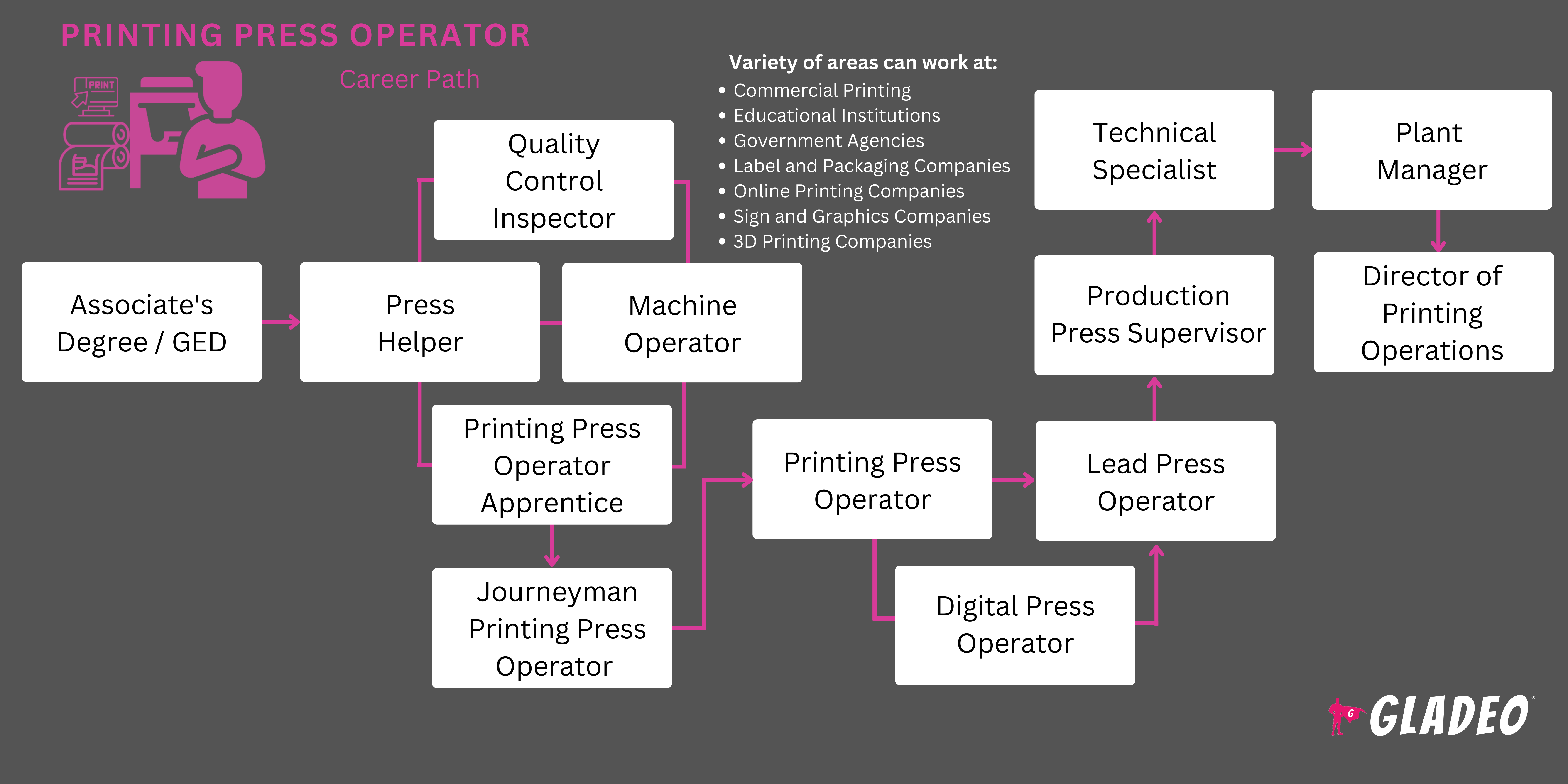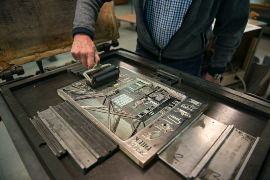Mga spotlight
Operator ng Digital Press, Operator ng Flexographic Press, Operator ng Offset Press, Offset Pressman, Operator ng Press, Pressman, Printer, Operator ng Printing Press, Printer Press, Operator ng Web Press, Operator ng Kagamitang Graphics, Operator ng Malaking Printing Press Setter at Set-Up
Naisip mo na ba kung paano ginagawa ang mga pahayagan, magasin, at libro? Malamang hindi. Pero ang proseso ay talagang kawili-wili at nangangailangan ng kasanayan ng mga modernong Operator ng Imprenta!
Ang mga behind-the-scenes na eksperto sa pag-iimprenta ang responsable sa pag-set up at pagpapatakbo ng mga maraming gamit at high-tech na makinang pang-imprenta na ginagamit sa malawakang produksyon ng mga naka-print na media ngayon. Kabilang dito ang offset printing para sa mga pahayagan, magasin, at libro; digital printing para sa mga limited-run at on-demand na libro; at mga letterpress para sa mga fine art print at stationery.
Ang mga Operator ng Imprenta ay nangangailangan ng matalas na mata sa detalye, mahusay na kasanayan sa mekanikal, at kakayahang mag-troubleshoot at lutasin ang mga problema nang mabilisan. Kung wala ang kanilang mga pagsisikap, hindi sana natin makukuha ang karamihan sa mga nakalimbag na materyales na ginagamit natin at binabalewala natin!
- Pagbibigay-buhay sa mga nakalimbag na materyales
- Pag-ambag sa produksyon ng mga publikasyon at mga materyales sa marketing
- Mga pagkakataong magtrabaho gamit ang mga advanced na teknolohiya sa pag-iimprenta
- Pakikipagtulungan sa mga malikhain at teknikal na propesyonal
Oras ng trabaho
- Ang mga Operator ng Imprenta ay nagtatrabaho nang full-time sa mga tindahan ng imprenta, mga bahay-limbagan, o mga pasilidad ng paggawa. Maaaring kabilang sa mga iskedyul ang mga gabi, katapusan ng linggo, at overtime upang matugunan ang mga deadline ng produksyon.
Mga Karaniwang Tungkulin
- Suriin ang mga job order. Tiyaking may sapat na stock ng tinta at papel na magagamit upang matugunan ang mga kahilingan sa dami ng pag-print
- Makipagtulungan sa mga departamento ng prepress at post-press
- Paghaluin ang tinta at punuin ang mga fountain ng tinta, kung kinakailangan
- Ihanda ang mga makinang pang-imprenta para sa mga pagpapatakbo ng produksyon. Magkabit ng mga printing plate, roller, at iba pang mga bahagi
- Tiyakin na ang halumigmig at temperatura sa lugar ng trabaho ay na-optimize upang maiwasan ang mga karaniwang isyu sa pag-imprenta at matiyak ang maayos na proseso ng produksyon.
- Magkarga ng papel, ayusin ang mga kontrol sa pagpapakain at pag-igting, at ilagay ang mga setting ng trabaho
- Mag-download/mag-scan ng mga digital na file gamit ang production software. Ayusin ang mga elemento ng pag-print
- Magpatakbo ng mga pantulong na kagamitan (para sa paggupit, pagtitiklop, paglalamina ng mga pahina, atbp.)
- Suriin ang mga paunang halimbawa ng mga nakalimbag na materyales (ibig sabihin, "mga pruweba") upang kumpirmahin ang wastong pagkakatakip at pagkakahanay ng tinta. Gumawa ng mga pagsasaayos, kung kinakailangan
- Mga digital, offset, o letterpress na makinang pangmonitor
- Mag-troubleshoot at mag-ayos ng mga problemang mekanikal
- Magsagawa ng regular na preventive maintenance at paglilinis
- Pangasiwaan ang mga kawani, ayon sa itinagubilin
Karagdagang Pananagutan
- Subaybayan ang mga antas ng imbentaryo at muling mag-order ng mga suplay
- Panatilihin ang mga talaan ng produksyon. I-archive ang media para sa sanggunian sa hinaharap
- Pamahalaan ang pag-iiskedyul at pagsubaybay sa trabaho
- Magsuot ng kinakailangang personal na kagamitang pangkaligtasan at sundin ang mga protocol sa kaligtasan
- Manatiling updated sa mga teknikal na manwal at mga bagong teknolohiya
Soft Skills
- Analitikal
- Pansin sa detalye
- Kakayahan sa pakikipag-usap
- Pagkamalikhain
- Kagalingan ng kamay
- Magandang paningin at paningin ng kulay
- Independent
- Kakayahang mekanikal
- Obserbasyon
- Organisasyon
- pasensya
- Pagpaplano
- Pagtugon sa suliranin
- Stamina
- Pagtutulungan ng magkakasama
- Pamamahala ng oras
- Visualization
Teknikal na kasanayan
- Kaalaman sa iba't ibang mga makinang pang-imprenta (digital, offset, letterpress, lithographic, flexographic , at gravure ) at mga pamutol ng papel
- Mga programa sa desktop publishing (Adobe Acrobat, Xerox FreeFlow)
- Pagpaplano ng mapagkukunan ng negosyo
- Pang-industriya na kontrol ng software
- Pamamahala ng imbentaryo
- Pamamahala ng proyekto
- Mga sistemang computer-to-plate (CTP)
- Mga digital na daloy ng trabaho
- Software para sa mga graphic (Illustrator, Photoshop, InDesign)
- Pag-unawa sa mga proseso ng prepress at post-press
- Kakayahang mag-troubleshoot at mag-ayos ng mga mekanikal na problema. Ligtas na paggamit ng mga kagamitan sa paglilinis, mga pampadulas sa makina, at iba't ibang kagamitang pangkamay
- Pamilyar sa teorya ng kulay at mga katangian ng tinta
- Kahusayan sa paggamit ng software sa pag-print
- Kaalaman sa mga uri ng papel at mga substrate para sa pag-print
- Mga tindahan ng imprenta
- Mga bahay-limbagan
- Ahensya sa advertising
- Mga kumpanya sa paggawa
- Mga kompanya ng packaging
Ang mga Operator ng Imprenta ay kinukuha upang makagawa ng mga de-kalidad na naka-print na materyales ayon sa mga deadline. Nangangailangan ito ng katumpakan, matalas na atensyon sa detalye, at kung minsan ay mahahabang oras upang matugunan ang mga iskedyul ng produksyon!
Kailangan nilang maging dalubhasa sa iba't ibang pamamaraan at teknolohiya sa pag-iimprenta habang tinitiyak na ang bawat pag-iimprenta ay pare-pareho at walang mga pagkakamali. Mahalaga ang katumpakan dahil kahit ang maliliit na pagkakamali ay maaaring humantong sa malalaking gastos kung sakaling kailanganing i-print muli. Gayunpaman, mahalaga rin ang pamamahala ng oras dahil sa masikip na oras ng pag-iimprenta. Bilang resulta, maaaring kailanganin nilang magtrabaho sa gabi at katapusan ng linggo upang maabot ang kanilang mga target at mapanatiling masaya ang mga customer.
Ang mga operator ng imprenta ay nangangailangan ng sapat na tibay dahil kailangan nilang tumayo nang matagal, magbuhat ng mabibigat na materyales, at magsagawa ng paulit-ulit na mga gawain. Mahalaga ang pagsunod sa mga protocol sa kaligtasan upang maiwasan ang mga pinsala at matiyak ang isang ligtas na kapaligiran sa pagtatrabaho.
Mabilis na niyayakap ng industriya ng pag-iimprenta ang mga teknolohiyang digital printing na nagbibigay-daan sa mas mabilis na pag-ikot at mas maraming opsyon sa pagpapasadya. Ang mga gawaing eco-friendly ay isa ring lumalaking trend sa mundo ng pag-iimprenta, kung saan ang mga kumpanya ay gumagamit ng mga recycled na materyales at mga tinta na nakabase sa tubig upang mabawasan ang epekto sa kapaligiran.
Isa pang trend ay ang automation at computerization ng maraming proseso ng pag-iimprenta, na nagbabawas sa pangangailangan para sa manu-manong interbensyon, nagpapalakas ng kahusayan, at nagpapabuti sa pangkalahatang produktibidad. Ang hindi magandang epekto ay ang pagbawas nito sa bilang ng mga Operator ng Printing Press na kakailanganin sa hinaharap.
Kasabay nito, ang mga materyales na nakalimbag ay nagiging hindi gaanong popular dahil ang mga mamimili ay lalong bumabaling sa mga digital na mapagkukunan. Gayunpaman, mayroong lumalaking merkado para sa mga materyales na print-on-demand pati na rin ang mga customized na high-end na packaging na nangangailangan ng mga advanced na printer.
Ang mga operator ng palimbagan ay maaaring nabighani sa kung paano gumagana ang mga bagay-bagay mula pa noong bata pa sila. Malamang na nasisiyahan sila sa pagtatrabaho gamit ang kanilang mga kamay, paggawa o pag-aayos ng mga bagay-bagay, at may interes sa teknolohiya at mga mekanikal na aparato.
- Ang mga Operator ng Printing Press ay nangangailangan ng kahit man lang diploma sa high school o GED
- Kumpletong bokasyonal na pagsasanay o isang associate degree sa graphic communications o isang kaugnay na larangan. Kasama sa mga karaniwang asignatura sa kurso ang:
- Teorya ng kulay
- Mga sistemang computer-to-plate (CTP)
- Mga digital na daloy ng trabaho
- Adobe Creative Suite (Photoshop, Illustrator, InDesign)
- Graphic na disenyo
- Pagpapanatili ng mekanikal
- Mga katangian ng papel at tinta
- Mga operasyon bago ang pag-imprenta
- Pagtatapos at pagbubuklod ng pag-print
- Teknolohiya sa pag-imprenta
- Mga protokol sa kaligtasan
- Ang ilang mga employer ay nagbibigay ng kumpletong on-the-job training o mga pagkakataon sa apprenticeship. Ang mga kaugnay na titulo ng apprenticeship ay maaaring kabilang ang:
- Katulong na Operator ng Pamamahayag
- Operator ng Embossing-Press
- Trabaho sa Pag-imprenta
- Operator ng Lithograph Press
- Operator ng Offset-Press
- Kasama sa mga opsyonal na programa sa sertipikasyon ang:
- Samahang Teknikal ng Flexograpiko -
1. Sertipikasyon ng Espesyalista sa Implementasyon
2. Sertipikasyon ng Operator ng PrePress
3. Sertipikasyon ng Operator ng Pamamahayag
4. In-Plant Printing and Mailing Association - Sertipikadong Tagapamahala ng Komunikasyon sa Graphics
- Hindi kailangan ng mga Operator ng Printing Press ang apat na taong degree ngunit maaaring makinabang mula sa mga kurso sa sertipiko at associate degree na may kaugnayan sa teknolohiya sa pag-imprenta, graphic communications, o mga kaugnay na larangan.
- Maghanap ng mga programa na may maayos at modernong mga makinang pang-imprenta kung saan makakakuha ka ng praktikal at praktikal na karanasan.
- Sa isip, ang mga programa ay dapat magkaroon ng mga batikang miyembro ng faculty at mga pagkakataon para sa mga internship o cooperative learning kasama ang mga lokal na employer.
- Isaalang-alang ang halaga ng matrikula, mga diskwento, at mga pagkakataon sa lokal na iskolarship (bilang karagdagan sa tulong na pederal).
- Kumuha ng mga kursong bokasyonal sa teknolohiya ng pag-iimprenta sa lalong madaling panahon. Isaalang-alang ang pagkuha ng sertipiko o associate degree
- Mag-sign up para sa mga klase sa graphic design, computer science, at mechanical engineering
- Magkaroon ng karanasan sa pamamagitan ng mga part-time na trabaho o internship sa mga print shop
- Sumali sa mga grupo o online forum na may kaugnayan sa pag-iimprenta. Mag-aral ng mga libro, online na artikulo, at mga video tutorial tungkol sa mga teknolohiya sa pag-iimprenta
- Simulan ang paggawa ng iyong resume at idagdag ito habang natututo ka at nakakakuha ng karanasan sa trabaho
- Suriin ang mga pag-post ng trabaho nang maaga upang makita kung ano ang mga karaniwang kinakailangan
- Humiling na magsagawa ng isang interbyu para sa impormasyon kasama ang mga nagtatrabahong Operator ng Imprenta. Subukang makipag-usap sa mga operator ng iba't ibang uri ng kagamitan. Tanungin kung maaari mo silang samahan sa trabaho nang isang araw.
- Gumawa ng listahan ng iyong mga contact (kabilang ang mga email address o numero ng telepono) na maaaring magsilbing mga sanggunian sa trabaho sa hinaharap
- Gumawa ng portfolio ng mga proyekto upang maipakita ang iyong mga kasanayan at makakuha ka ng praktikal na karanasan.

- Tingnan ang mga portal ng trabaho gaya ng Indeed , Simply Hired , Glassdoor , at Craigslist
- Maghanap ng mga trabaho bilang apprenticeship at printing assistant para makapagsimula ka
- Magtanong sa mga nagtatrabahong Operator ng Imprenta para sa mga tip sa paghahanap ng trabaho
- Humingi ng tulong sa career center ng iyong paaralan sa pagkonekta sa mga recruiter at job fair
- Magtanong nang maaga sa mga potensyal na sanggunian upang makita kung irerekomenda ka nila o magsulat ng mga liham ng sanggunian
- Tingnan ang mga online na template ng resume para sa Operator ng Printing Press at suriin ang mga potensyal na tanong sa interbyu sa trabaho
- Pag-aralan ang mga terminolohiya at balita tungkol sa larangan bago tumungo sa mga panayam. Maging handa na talakayin ang iyong mga pananaw tungkol sa mga uso at pagsulong.
- Alamin kung paano manamit para sa isang job interview !
- Maging masigasig sa pagtukoy ng mga pagkakamali, pagsasagawa ng preventive maintenance, at pagtugon sa mga deadline ng produksyon
- Tanungin ang iyong superbisor kung paano mo mapapahusay ang iyong kaalaman at kasanayan upang mas mapaglingkuran ang kumpanya
- Pag-aralan ang mga gabay sa tagagawa at software. Maging eksperto sa mga programa (tulad ng mga nasa Adobe Creative Suite) at mga makinang pang-imprenta na iyong ginagamit.
- Alisin ang mga espesyalisadong sertipikasyon na may kaugnayan sa mga bagong pamamaraan at teknolohiya. Nag-aalok ang Flexographic Technical Association ng mga sertipikasyon tulad ng PrePress Operator Certification at Press
Sertipikasyon ng Operator na maaaring maging kapaki-pakinabang! - Ipakita na kaya mong magtrabaho nang nakapag-iisa at epektibong pangasiwaan ang mga pangkat
- Sanayin ang mga bagong manggagawa nang may pagtitiis at lubusan
- Palaging magsuot ng angkop na personal na kagamitang pangproteksyon upang maiwasan ang mga aksidente at panganib
- Sumulat ng mga artikulong "paano gawin" upang maitatag ang iyong sarili bilang isang nangunguna sa industriya
- Magsaliksik sa iba't ibang uri ng mga paraan ng pag-iimprenta upang mapalawak ang iyong mga abot-tanaw
- Isaalang-alang ang paglipat ng lugar kung kinakailangan upang mapaunlad ang iyong karera! Ang mga estado na may pinakamataas na konsentrasyon ng mga kaugnay na trabaho ay ang Wisconsin, Nebraska, Minnesota, Kansas, at Illinois.
Mga website
- Asosasyon para sa mga Teknolohiya ng PRINT
- Samahang Teknikal ng Flexographic
- Pandaigdigang Kapatiran ng mga Teamster
- Pandaigdigang Alyansa ng Digital na Negosyo (IDEAlliance)
- Asosasyon ng Komunikasyon sa Pag-imprenta at Grapiko
- PAGLIMBAG Nagkakaisang Alyansa
Mga libro
- Pocket Pal: Isang Handbook sa Produksyon ng Sining Grapiko , ni Frank Romano
- Produksyon ng Pag-iimprenta gamit ang Adobe Creative Cloud , ni Claudia McCue
- Ang Handbook ng Pag-imprenta , ng The Print Handbook Co.
Mahalaga ang mga Operator ng Imprenta sa industriya ng pag-iimprenta, ngunit maaaring limitado ang paglago ng trabaho sa larangang ito dahil lumilipat ang mga mamimili mula sa mga nakalimbag na materyales patungo sa mga digital na materyales. Isa pa rin itong mabisang opsyon sa karera, ngunit kung interesado ka sa iba pang mga trabaho, tingnan ang aming listahan sa ibaba!
- Manggagawa sa Pagtatali
- Operator ng Makina sa Pagputol, Pagsuntok, at Pindutin
- Operator ng Digital Press
- Grapikong taga-disenyo
- Operator ng Milling at Planing Machine
- Maramihang Tagatakda ng Kagamitang Makina
- Tekniko ng Pag-iimpake
- Makinang Pang-ayos ng mga Gamit na Papel
- Manggagawa sa Proseso ng Potograpiya
- Tekniko ng Prepress
- Tagaplano ng Produksyon
- Inspektor ng Kontrol ng Kalidad
Newsfeed

Mga Tampok na Trabaho

Mga Online na Kurso at Tool

Mga Inaasahan sa Taunang Sahod
Ang mga bagong manggagawa ay nagsisimula sa humigit-kumulang $45K. Ang median na suweldo ay $52K bawat taon. Ang mga manggagawang may mataas na karanasan ay maaaring kumita ng humigit-kumulang $63K.
Mga Inaasahan sa Taunang Sahod
Ang mga bagong manggagawa ay nagsisimula sa humigit-kumulang $45K. Ang median na suweldo ay $50K bawat taon. Ang mga manggagawang may mataas na karanasan ay maaaring kumita ng humigit-kumulang $64K.
Mga Inaasahan sa Taunang Sahod
Ang mga bagong manggagawa ay nagsisimula sa humigit-kumulang $38K. Ang median na suweldo ay $45K bawat taon. Ang mga manggagawang may mataas na karanasan ay maaaring kumita ng humigit-kumulang $50K.
Mga Inaasahan sa Taunang Sahod
Ang mga bagong manggagawa ay nagsisimula sa humigit-kumulang $39K. Ang median na suweldo ay $48K bawat taon. Ang mga manggagawang may mataas na karanasan ay maaaring kumita ng humigit-kumulang $62K.
Mga Inaasahan sa Taunang Sahod
Ang mga bagong manggagawa ay nagsisimula sa humigit-kumulang $37K. Ang median na suweldo ay $46K bawat taon. Ang mga manggagawang may mataas na karanasan ay maaaring kumita ng humigit-kumulang $60K.






